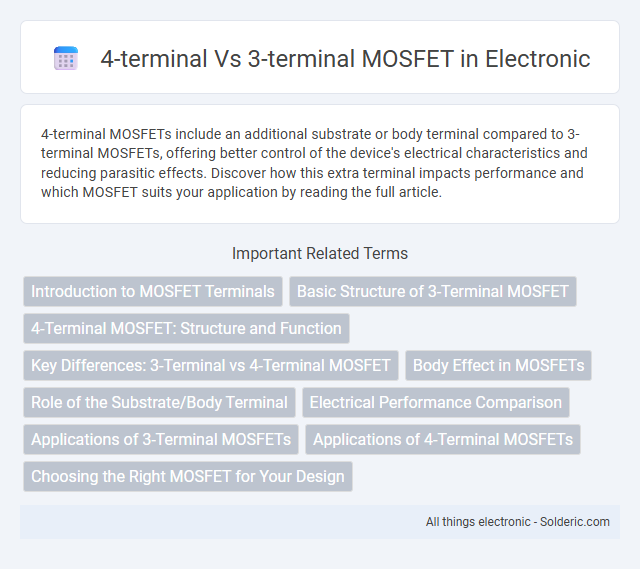4-terminal MOSFETs include an additional substrate or body terminal compared to 3-terminal MOSFETs, offering better control of the device's electrical characteristics and reducing parasitic effects. Discover how this extra terminal impacts performance and which MOSFET suits your application by reading the full article.
Comparison Table
| Feature | 4-Terminal MOSFET | 3-Terminal MOSFET |
|---|---|---|
| Terminals | Drain, Source, Gate, Body (Bulk) | Drain, Source, Gate |
| Body Connection | Separate body terminal available | Body internally connected to source |
| Body Effect Control | Direct control over body terminal voltage | No direct control, body effect linked to source voltage |
| Applications | Analog circuits, precise threshold voltage control | Digital circuits, basic switching applications |
| Complexity | Higher due to additional terminal | Lower, simpler device structure |
| Cost | Higher manufacturing cost | Lower manufacturing cost |
| Device Types | Used for depletion and enhancement mode variants | Primarily enhancement mode devices |
Introduction to MOSFET Terminals
MOSFETs typically feature three terminals: gate, drain, and source, which control current flow through the device. A 4-terminal MOSFET includes an additional body or substrate terminal, allowing better control over body effect and threshold voltage. Understanding the role of each terminal helps you optimize circuit performance and device reliability.
Basic Structure of 3-Terminal MOSFET
The basic structure of a 3-terminal MOSFET consists of the source, drain, and gate terminals, where the gate controls the current flow between the source and drain through a thin insulating oxide layer. Unlike 4-terminal MOSFETs, which include a body or substrate terminal to control the device's threshold voltage and body effect, 3-terminal MOSFETs rely solely on the gate voltage to modulate conductivity. Your design considerations should focus on how the 3-terminal configuration simplifies circuit integration but may limit control over certain electrical characteristics compared to 4-terminal devices.
4-Terminal MOSFET: Structure and Function
The 4-terminal MOSFET includes a separate substrate or body terminal in addition to the gate, drain, and source terminals found in 3-terminal MOSFETs. This body terminal allows enhanced control over the device's threshold voltage and helps mitigate substrate bias effects, improving performance in analog and high-frequency applications. Understanding the structure and function of 4-terminal MOSFETs enables you to optimize circuit design by leveraging body effect control for better device behavior.
Key Differences: 3-Terminal vs 4-Terminal MOSFET
A 3-terminal MOSFET consists of the gate, drain, and source terminals, while a 4-terminal MOSFET includes an additional body (bulk) terminal that connects to the substrate. The body terminal in 4-terminal MOSFETs allows independent control of the substrate potential, enabling reduced body effect and improved device performance such as higher threshold voltage stability. In contrast, 3-terminal MOSFETs have the body terminal internally connected to the source, limiting substrate bias control and influencing characteristics like threshold voltage and leakage current.
Body Effect in MOSFETs
The body effect in MOSFETs occurs when the source-to-body voltage influences the threshold voltage, affecting device performance and increasing power consumption. A 4-terminal MOSFET, which includes a separate body (bulk) terminal, allows for direct control and measurement of this effect, enabling better optimization of circuit behavior. In contrast, a 3-terminal MOSFET typically has the body terminal internally connected to the source, limiting your ability to manage the body effect and potentially causing variability in threshold voltage.
Role of the Substrate/Body Terminal
The substrate or body terminal in a 4-terminal MOSFET plays a crucial role in controlling the threshold voltage and minimizing body effect by providing a separate connection to the semiconductor body. In contrast, a 3-terminal MOSFET lacks an independent body terminal, as the substrate is internally connected to the source, limiting its ability to adjust the body bias. This distinction impacts device performance, with 4-terminal MOSFETs offering enhanced control over leakage currents and switching characteristics through body bias modulation.
Electrical Performance Comparison
4-terminal MOSFETs offer improved electrical performance over 3-terminal MOSFETs by providing an additional bulk or body terminal, enabling better control of the substrate potential and reducing body effect. This leads to lower threshold voltage variation, improved switching speed, and reduced leakage current. The enhanced control in 4-terminal devices results in higher efficiency and reliability in applications requiring precise voltage regulation and fast switching.
Applications of 3-Terminal MOSFETs
3-terminal MOSFETs are widely used in switching applications such as power supplies, motor controllers, and digital circuits due to their simplicity and ease of integration. These devices are preferred in low-voltage, low-power environments where efficient control of current is essential. Their compatibility with integrated circuit fabrication and straightforward gate control make them ideal for signal amplification and switching tasks in consumer electronics and automotive systems.
Applications of 4-Terminal MOSFETs
4-terminal MOSFETs, featuring an isolated body terminal, are ideal for applications requiring precise control of the body effect, such as in analog circuits and high-frequency switching where substrate biasing improves performance and reduces leakage. These devices enable engineers to independently manipulate the body potential, enhancing device stability and minimizing parasitic effects, which is crucial in RF amplifiers and power management systems. Your designs benefit from increased flexibility and efficiency when using 4-terminal MOSFETs in complex integrated circuits or sensitive measurement equipment.
Choosing the Right MOSFET for Your Design
Selecting the ideal MOSFET for your design depends on the application requirements, where 4-terminal MOSFETs offer enhanced control with an isolated body diode and reduced parasitic capacitance, improving efficiency in high-frequency circuits. In contrast, 3-terminal MOSFETs are simpler, cost-effective, and suitable for general switching applications with standard performance. Understanding thermal management, switching speed, and threshold voltage specifications ensures optimal device performance and reliability in your electronic design.
4-terminal vs 3-terminal MOSFET Infographic

 solderic.com
solderic.com